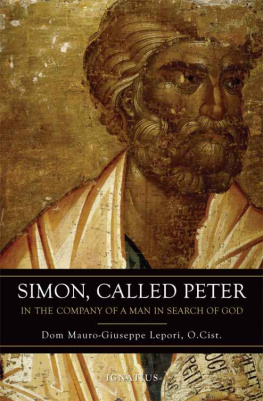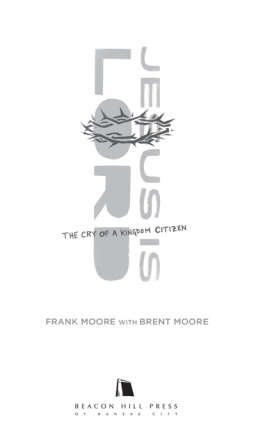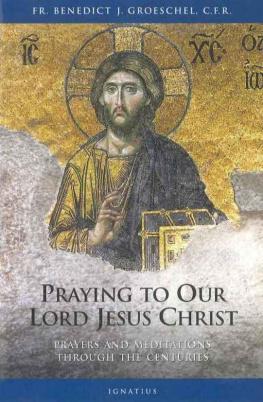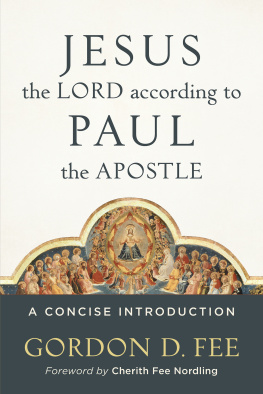SIMON CALLED PETER
DOM MAURO GIUSEPPE LEPORI
Simon Called Peter
In the Footsteps of a Man Following God
FOREWORD BY
ANGELO SCOLA
TRANSLATED BY
MATTHEW SHERRY
IGNATIUS PRESS SAN FRANCISCO
Original Italian edition:
Simon Chiamato Pietro: Sui passi di un uomo alla sequela di Dio
2004 by Casa Editrice Marietti, S.p.A., Genoa and Milan
Unless otherwise noted, Scripture quotations have been taken from the Revised Standard Version of the Holy Bible, Second Catholic Edition, 2006. The Revised Standard Version of the Holy Bible: the Old Testament, 1952, 2006; the Apocrypha, 1957, 2006; the New Testament, 1946, 2006; the Catholic Edition of the Old Testament, incorporating the Apocrypha, 1966, 2006, the Catholic Edition of the New Testament, 1965, 2006 by the Division of Christian Education of the National Council of the Churches of Christ in the United States of America. All rights reserved. In some cases the Scripture has been adapted so as to accommodate the authors points, since he was quoting from an Italian translation of the Holy Bible.
Ignatius Press is grateful to Sister Maria, whose draft translation brought this special book to our attention.
Cover art:
Icon of St. Peter. From Constantinople
(modern Istanbul, Turkey), around A.D. 1320.
British Museum, London, Great Britain.
The Trustees of the British Museum / Art Resource, N.Y.
Cover design by Roxanne Mei Lum
2010 by Ignatius Press, San Francisco
All rights reserved
ISBN 978-1-58617-271-8
Library of Congress Control Number 2009934935
Printed in the United States of America
To my community,
a gentle school
of the filial and fraternal
paternity of Christ
Contents
Foreword
I am grateful to Father Mauro Lepori, not only for what he has written in this book, but also for how he wrote it.
In fact, as I was reading it, I was again reminded of the wonders of the written page. The account takes you inside the eventsin this case, the life of Simon Peterand you see them with your own eyes; they penetrate your heart even more than if you had actually witnessed them.
Christian art has a special ability to do this, because it shares in the power of the Redeemer, who is closer to me than I am to myself, to penetrate the psyche.
So when, as in this case, the depiction of a saint emerges from a vigorous effort to get inside his human experience (the attempt to walk in the footsteps of a man following God, as this books subtitle says), it breaks through the limitations of mere biography.
This book provides keen psychological insight into the life of the Prince of the Apostles, presenting an unmistakably human face in which we can all recognize some part of ourselves. So in addition to being an exquisite meditation, this book can also be read as a basicbut by no means dullintroduction to Christian anthropology.
Lets whet our appetite with a little sample.
In the first several pages, there is the description of how faith arises from an encounter that reveals man to himself: Simon had never understood so clearly how important his life and freedom were. Or there is the insight into celibacy as the supreme exaltation of the natural capacity for affection: So Simon left everything behind, in order that nothing might be lost.
For him, following Christ (It was as if he had followed the Master where he was going, not only with his footsteps, but with his heart, his decisions, his teaching, his works) was the perfection of freedom and starkly highlighted the drama it entails: He would never be able to reach the full depth of their friendship without embracing the Masters obscure destiny.
Peter had to face more and more clearly the fact that his integrity and salvation were to be found in his relationship with this Man: Without him... he had nothing to think about except his own nothingness.
This meant achieving complete human maturity through the unbreakable bond between his Yes to Christ and his mission, in joyful obedience to the law of love: giving ones life for the work of Another. They no longer had a moment for themselves: from sunrise to sunset, it was as if they were suspended between the mercy of Christ and human misery.
Simon Called Peter is an instance of a book being much more than just a book, as Guardini said: it is an encounter that adds another precious link to the chain of human friendship.
ANGELO CARDINAL SCOLA
Patriarch of Venice
Venice, April 25, 2004
Solemnity of Saint Mark
the Evangelist
Introduction
And when they had brought their boats to land, they left everything and followed him (Lk 5:11).
Is there anyone who is not moved by the witness of absolute dedication to Christ? This is the allure of the saints, whom the Church never tires of contemplating and of presenting as proof that it is possible to follow Jesus Christ with our entire selves, that it is possible to make a radical commitment to the Son of God, the way, the truth, and the life of man. The saints address our desire for the fullness of life and tell us that this is not an illusion, that it is not a mirage, but a call that resounds in the heart of every man and requires fulfillment. The answer to this desire is not a dream but rather the realism of following Christ. The realism of following Christ is demonstrated by the saints, those who followed him before us, leading us on toward him in an invisible chain stretching from the first steps of Mary and the apostles throughout all of history, until the Second Coming.
They left everything and followed him. The allure of this radical response is lost unless we ourselves are moved by what we see in the saints and ask ourselves, What does leaving everything to follow the Lord mean for us? The saints teach us that the answer to this question is not the same for everyone. The saints teach us that leaving everything does not come before the act of followinginstead, these two things happen at the same time. Leaving everything is done not only at the beginning but during the entire journey. Only death confirms, once and for all, our leaving everything behind in order to be with the Lord forever. Following him is a constant, renewed leaving everything. It is never finished and continually requires a fresh commitment, as if each of the Lords footsteps created another everything between himself and our freedom, a new everything to be left behind once again. This is how the love of Christ continues to live and grow.
The disciple and apostle Simon Peter is one of the most emblematic figures of the gripping drama of following Christ. He left everything right at the start, without hesitation, but he still had to confront the claims made on his freedom by Jesus, by circumstances, and by his own fragility and repeat his initial Yes to the very end. Peters denial, but also the tradition of Quo vadis?his last attempt to escape the total Yes of martyrdom by leaving Rome, and his encounter with Jesus, who asked him for a definitive leaving everything in dying for himhelp us to understand that the freedom of total self-donation to Christ is a lifelong commitment. Because this commitment is asked of us by the Lord, it is always possible, in spite of everything, as for the repentant thief crucified next to Jesus.
At every stage of my journey as a man, a Christian, a monk, and an abbot, I have found Saint Peter as a companion walking ahead of me with my own humanity, with my own human poverty, full of contradictions. Peter is the saint in the Gospels who is most like us, the closest to our humanity, and yet also very close to Christ. We can always follow Peter. He always leads us to Jesus, he unites us to Jesus, because he never permitted his own fragility to separate his heart from Christ, even when he denied him.
Next page








